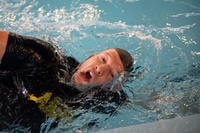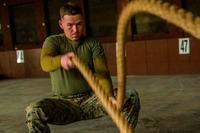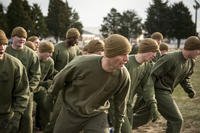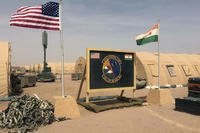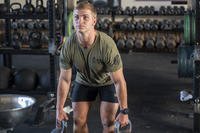If you want to wear the green beret of the Army Special Forces, be warned: It takes more than the ability to do hundreds of push-ups. To make it in the Special Forces of any branch of the U.S. military, you need intelligence, an outstanding record of previous military service (at least three years) and very high motivation. But now, a new program will enable you to go straight to the Special Forces Assessment and Selection (SFAS) after Army Boot Camp -- skipping the three-year wait. Ask your local Army recruiter for more details.
My next few columns are for those of you who think you have what it takes to go Special Forces. I can give you the requirements for each service and a workout that will help you get physically prepared for the advanced training. As for those other qualities, you're on your own.
Getting Into SFAS
The first step to wearing the green beret is to pass the SFAS course. To get into this course, you must meet some basic physical fitness requirements by scoring a minimum of 260 on the Army physical fitness test for the 17-21 age group. Remember, that's the minimum score.
Visit Military.com's Special Operations Forces Center
If you're serious about applying for Special Forces, however, never settle for the minimum score in anything. Since the Green Berets are so selective and competitive, it helps to stand out in as many areas as you can. I recommend that you work toward these goals in your Army PFT:
- Complete the two-mile run in at least 12-14 minutes
- 100 sit-ups in two minutes
- 100 push-ups in two minutes
Accomplishing these goals will bring you close to a perfect score of 300 and increase your chances of being selected for SFAS.
The three-week SFAS course, taught at Fort Bragg, N.C., consists of two phases. During the first, the physical phase, you will be expected to PT (running, swimming, sit-ups, pull-ups, push-ups), run an obstacle course and participate in rucksack marches and orienteering exercises. The second phase measures your leadership and teamwork abilities.
Related Video:
Next Step: The Q Course
After completing SFAS, you will be selected by the Army SF instructors to attend the "Q Course," the Special Forces Qualification Course (SFQC). Depending on your occupational specialty, this course will last from six months to a year; the medical and communications courses last longer.
Daily training at the SFQC takes its toll on your body since your day usually starts very early and ends late. While you are training for the Q Course, you should adopt the attitude of a marathon runner. Be ready for the long haul but take each day one at a time. Most people who quit the course lack the ability to focus through the fatigue and stress that accompanies such training.
The Workout
If Army Special Forces is your goal, here's a good starter workout that may help you reach it.
Swimming: Never Swim Alone
- Two to three times a week, 1,000 to 2,000 meters each time.
- One day a week, try to swim wearing cammies and boots for 100 meters.
- Wear fins when swimming half the time as well.
Running:
- Four to five times a week, 3-5 miles as fast as you can.
- Twice a week, do rucksack marches carrying a 30- to 50-pound load marching 5-15 miles at a fast walking pace.
PT: Every Other Day
- Pull-ups, 75 to 100 repetitions (seven to 10 sets of 10 reps).
- Push-ups, 200 to 300 repetitions (10 to 15 sets of 20 reps).
- Sit-ups, 200 to 300 repetitions (five to 10 sets of 40 to 50 reps).
Related Video:
It's always a good idea to check with your physician before starting a new exercise program, especially if you have been inactive for a while or if you have certain medical conditions.
More Army Special Forces Articles:
- Army Special Forces overview
- Army Green Beret training
- Army Ranger PFT
- Preparing for Army Ranger School
- Weight gain for Ranger School
- Army Airborne PFT
- All Army Special Forces articles
Many of my favorite PT programs to train for the Army PFT can be found in the following Military.com links:
Other related Army fitness articles:
- Army basic training PFT requirements
- Army weight standards
- Army fitness workout plan
- Army Ranger fitness
- Performing for the Special Forces
- Physical fitness test anxiety
Stew Smith is a former Navy SEAL and fitness author certified as a Strength and Conditioning Specialist (CSCS) with the National Strength and Conditioning Association. Visit his Fitness eBook store if you’re looking to start a workout program to create a healthy lifestyle. Send your fitness questions to stew@stewsmith.com.
Want to Learn More About Military Life?
Whether you're thinking of joining the military, looking for fitness and basic training tips, or keeping up with military life and benefits, Military.com has you covered. Subscribe to Military.com to have military news, updates and resources delivered directly to your inbox.


